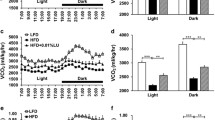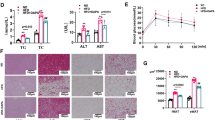Abstract
Purpose
Myricetin, a dietary flavonoid, is effective in the treatment of obesity and insulin resistance by increasing glucose transport and lipogenesis in adipocyte and diminishing systemic inflammation in obesity. However, it has not been revealed yet whether myricetin is associated with brown adipose tissue (BAT) activation that tightly mediates systemic energy metabolism. Therefore, this study assessed whether myricetin activated brown adipose tissue in db/db mouse.
Methods
Myricetin (400 mg/kg) in distilled water was fed daily by oral gavage to leptin receptor-deficient db/db male mice at 4 weeks of age for 14 weeks. Body weight change, glucose intolerance test, blood lipid profile and BAT activation using PET-CT were assessed.
Results
After myricetin treatment for 14 weeks, systemic insulin resistance and hepatic steatosis were significantly improved in db/db mice with body weight reduction and myricetin led to decreased adipocity, improved plasma lipid profiles and increased energy expenditure. Myricetin activated BAT by upregulating thermogenic protein expression and activating mitochondrial biogenesis, eventually increasing heat dissipation in skin after cold exposure. In iWAT, myricetin induced beige formation, increased thermogenic protein expression and activated mitochondrial biogenesis. Consistently, thermogenic gene expression was upregulated when myricetin was introduced in C3H10T1/2 cells during brown adipocytes differentiation. Moreover, the expression level of adiponectin was significantly increased in C3H10T1/2 cells, adipose tissues and plasma after myricetin treatment.
Conclusions
These results highlight that myricetin prevents obesity and systemic insulin resistance by activating BAT and increasing adiponectin expression in BAT.







Similar content being viewed by others
Abbreviations
- BAT:
-
Brown adipose tissue
- iWAT:
-
Inguinal white adipose tissue
- PGC1-α:
-
Peroxisome proliferator-activated receptor gamma coactivator 1-alpha
- PGC1-β:
-
Peroxisome proliferator-activated receptor gamma coactivator 1-beta
- UCP1:
-
Uncoupling protein-1
- CHO:
-
Cholesterol
- TG:
-
Triacylglyceride
- LDL:
-
Low-density lipoprotein
- HDL:
-
High-density lipoprotein
- ATP5A:
-
ATP synthase, H + transporting, mitochondrial F1 complex, alpha 1
- UQCRC2:
-
Cytochrome b-c1 complex subunit 2
- SDHB:
-
Succinate dehydrogenase [ubiquinone] iron–sulfur subunit, mitochondrial
- SIRT1:
-
NAD-dependent deacetylase sirtuin-1
- GAPDH:
-
Glyceraldehyde 3-phosphate dehydrogenase
- TH:
-
Tyrosine hydroxylase
- dio2:
-
Dopamine and iodothyronine deiodinase types 2
- TBX1:
-
T-box transcription factor TBX1
- TMEM26:
-
Transmembrane protein 26
References
Jensen MD, Ryan DH, Apovian CM, Ard JD, Comuzzie AG, Donato KA, Hu FB, Hubbard VS, Jakicic JM, Kushner RF, Loria CM, Millen BE, Nonas CA, Pi-Sunyer FX, Stevens J, Stevens VJ, Wadden TA, Wolfe BM, Yanovski SZ (2014) 2013 AHA/ACC/TOS guideline for the management of overweight and obesity in adults: a report of the American College of Cardiology/American Heart Association Task Force on Practice Guidelines and The Obesity Society. J Am Coll Cardiol 63 (25 Pt B):2985–3023. doi:10.1016/j.jacc.2013.11.004
Flegal KM, Kit BK, Orpana H, Graubard BI (2013) Association of all-cause mortality with overweight and obesity using standard body mass index categories: a systematic review and meta-analysis. Jama 309(1):71–82. doi:10.1001/jama.2012.113905
Solas M, Milagro FI, Martinez-Urbistondo D, Ramirez MJ, Martinez JA (2016) Precision obesity treatments including pharmacogenetic and nutrigenetic approaches. Trends Pharmacol Sci 37(7):575–593. doi:10.1016/j.tips.2016.04.008
Virtanen KA, Lidell ME, Orava J, Heglind M, Westergren R, Niemi T, Taittonen M, Laine J, Savisto NJ, Enerback S, Nuutila P (2009) Functional brown adipose tissue in healthy adults. N Engl J Med 360(15):1518–1525. doi:10.1056/NEJMoa0808949
van Marken Lichtenbelt WD, Vanhommerig JW, Smulders NM, Drossaerts JM, Kemerink GJ, Bouvy ND, Schrauwen P, Teule GJ (2009) Cold-activated brown adipose tissue in healthy men. N Engl J Med 360(15):1500–1508. doi:10.1056/NEJMoa0808718
Sidossis L, Kajimura S (2015) Brown and beige fat in humans: thermogenic adipocytes that control energy and glucose homeostasis. J Clin Invest 125(2):478–486. doi:10.1172/JCI78362
Schulz TJ, Tseng YH (2009) Emerging role of bone morphogenetic proteins in adipogenesis and energy metabolism. Cytokine Growth Factor Rev 20(5–6):523–531. doi:10.1016/j.cytogfr.2009.10.019
Gesta S, Tseng YH, Kahn CR (2007) Developmental origin of fat: tracking obesity to its source. Cell 131(2):242–256. doi:10.1016/j.cell.2007.10.004
Kim SH, Plutzky J (2016) Brown fat and browning for the treatment of obesity and related metabolic disorders. Diabetes Metab J 40(1):12–21. doi:10.4093/dmj.2016.40.1.12
Hankir MK, Cowley MA, Fenske WK (2016) A BAT-centric approach to the treatment of diabetes: turn on the brain. Cell Metab 24(1):31–40. doi:10.1016/j.cmet.2016.05.003
Liu X, Zheng Z, Zhu X, Meng M, Li L, Shen Y, Chi Q, Wang D, Zhang Z, Li C, Li Y, Xue Y, Speakman JR, Jin W (2013) Brown adipose tissue transplantation improves whole-body energy metabolism. Cell Res 23(6):851–854. doi:10.1038/cr.2013.64
Liu X, Wang S, You Y, Meng M, Zheng Z, Dong M, Lin J, Zhao Q, Zhang C, Yuan X, Hu T, Liu L, Huang Y, Zhang L, Wang D, Zhan J, Jong Lee H, Speakman JR, Jin W (2015) Brown adipose tissue transplantation reverses obesity in Ob/Ob Mice. Endocrinology 156(7):2461–2469. doi:10.1210/en.2014-1598
Yuan X, Hu T, Zhao H, Huang Y, Ye R, Lin J, Zhang C, Zhang H, Wei G, Zhou H, Dong M, Zhao J, Wang H, Liu Q, Lee HJ, Jin W, Chen ZJ (2016) Brown adipose tissue transplantation ameliorates polycystic ovary syndrome. Proc Natl Acad Sci USA. doi:10.1073/pnas.1523236113
Cypess AM, Lehman S, Williams G, Tal I, Rodman D, Goldfine AB, Kuo FC, Palmer EL, Tseng Y, Doria A, Kolodny GM, Kahn CR (2009) Identification and importance of brown adipose tissue in adult humans. N Engl J Med 360(15):1509–1517
Ohno H, Shinoda K, Spiegelman BM, Kajimura S (2012) PPARgamma agonists induce a white-to-brown fat conversion through stabilization of PRDM16 protein. Cell Metab 15(3):395–404. doi:10.1016/j.cmet.2012.01.019
Shabalina IG, Petrovic N, de Jong JM, Kalinovich AV, Cannon B, Nedergaard J (2013) UCP1 in brite/beige adipose tissue mitochondria is functionally thermogenic. Cell Rep 5(5):1196–1203. doi:10.1016/j.celrep.2013.10.044
Min SY, Kady J, Nam M, Rojas-Rodriguez R, Berkenwald A, Kim JH, Noh HL, Kim JK, Cooper MP, Fitzgibbons T, Brehm MA, Corvera S (2016) Human ‘brite/beige’ adipocytes develop from capillary networks, and their implantation improves metabolic homeostasis in mice. Nat Med 22(3):312–318. doi:10.1038/nm.4031
Miean KH, Mohamed S (2001) Flavonoid (myricetin, quercetin, kaempferol, luteolin, and apigenin) content of edible tropical plants. J Agric Food Chem 49(6):3106–3112
Semwal DK, Semwal RB, Combrinck S, Viljoen A (2016) Myricetin: a dietary molecule with diverse biological activities. Nutrients 8(2):90. doi:10.3390/nu8020090
Ong KC, Khoo HE (2000) Effects of myricetin on glycemia and glycogen metabolism in diabetic rats. Life Sci 67(14):1695–1705
Kandasamy N, Ashokkumar N (2014) Protective effect of bioflavonoid myricetin enhances carbohydrate metabolic enzymes and insulin signaling molecules in streptozotocin-cadmium induced diabetic nephrotoxic rats. Toxicol Appl Pharmacol 279(2):173–185. doi:10.1016/j.taap.2014.05.014
Choi HN, Kang MJ, Lee SJ, Kim JI (2014) Ameliorative effect of myricetin on insulin resistance in mice fed a high-fat, high-sucrose diet. Nutr Res Pract 8 (5):544–549. doi:10.4162/nrp.2014.8.5.544
Guo J, Meng Y, Zhao Y, Hu Y, Ren D, Yang X (2015) Myricetin derived from Hovenia dulcis Thunb. ameliorates vascular endothelial dysfunction and liver injury in high choline-fed mice. Food Funct 6 (5):1620–1634. doi:10.1039/c4fo01073f
Chi QS, Wang DH (2011) Thermal physiology and energetics in male desert hamsters (Phodopus roborovskii) during cold acclimation. J Comp Physiol B 181(1):91–103. doi:10.1007/s00360-010-0506-6
Chen HC, Farese RV Jr (2002) Determination of adipocyte size by computer image analysis. J Lipid Res 43(6):986–989
Livak KJ, Schmittgen TD (2001) Analysis of relative gene expression data using real-time quantitative PCR and the 2(-Delta Delta C(T)) method. Methods 25(4):402–408. doi:10.1006/meth.2001.1262
Seale P, Kajimura S, Yang W, Chin S, Rohas LM, Uldry M, Tavernier G, Langin D, Spiegelman BM (2007) Transcriptional control of brown fat determination by PRDM16. Cell Metab 6(1):38–54. doi:10.1016/j.cmet.2007.06.001
Wang B, Chandrasekera PC, Pippin JJ (2014) Leptin- and leptin receptor-deficient rodent models: relevance for human type 2 diabetes. Curr Diabetes Rev 10(2):131–145
de Luca C, Kowalski TJ, Zhang Y, Elmquist JK, Lee C, Kilimann MW, Ludwig T, Liu SM, Chua SC Jr (2005) Complete rescue of obesity, diabetes, and infertility in db/db mice by neuron-specific LEPR-B transgenes. J Clin Invest 115(12):3484–3493. doi:10.1172/jci24059
Rosen ED, Spiegelman BM (2014) What we talk about when we talk about fat. Cell 156(1–2):20–44. doi:10.1016/j.cell.2013.12.012
Himms-Hagen J (1984) Nonshivering thermogenesis. Brain Res Bull 12(2):151–160
Ribeiro MO, Carvalho SD, Schultz JJ, Chiellini G, Scanlan TS, Bianco AC, Brent GA (2001) Thyroid hormone–sympathetic interaction and adaptive thermogenesis are thyroid hormone receptor isoform–specific. J Clin Invest 108(1):97–105. doi:10.1172/jci12584
Cohen P, Spiegelman BM (2015) Brown and beige fat: molecular parts of a thermogenic machine. Diabetes 64(7):2346–2351. doi:10.2337/db15-0318
Wu J, Bostrom P, Sparks LM, Ye L, Choi JH, Giang AH, Khandekar M, Virtanen KA, Nuutila P, Schaart G, Huang K, Tu H, van Marken Lichtenbelt WD, Hoeks J, Enerback S, Schrauwen P, Spiegelman BM (2012) Beige adipocytes are a distinct type of thermogenic fat cell in mouse and human. Cell 150(2):366–376. doi:10.1016/j.cell.2012.05.016
Yamauchi T, Kamon J, Waki H, Terauchi Y, Kubota N, Hara K, Mori Y, Ide T, Murakami K, Tsuboyama-Kasaoka N, Ezaki O, Akanuma Y, Gavrilova O, Vinson C, Reitman ML, Kagechika H, Shudo K, Yoda M, Nakano Y, Tobe K, Nagai R, Kimura S, Tomita M, Froguel P, Kadowaki T (2001) The fat-derived hormone adiponectin reverses insulin resistance associated with both lipoatrophy and obesity. Nat Med 7(8):941–946. doi:10.1038/90984
Carey AL, Kingwell BA (2013) Brown adipose tissue in humans: therapeutic potential to combat obesity. Pharmacol Ther 140(1):26–33. doi:10.1016/j.pharmthera.2013.05.009
Bi S, Li L (2013) Browning of white adipose tissue: role of hypothalamic signaling. Ann N Y Acad Sci 1302:30–34. doi:10.1111/nyas.12258
Price NL, Gomes AP, Ling AJ, Duarte FV, Martin-Montalvo A, North BJ, Agarwal B, Ye L, Ramadori G, Teodoro JS, Hubbard BP, Varela AT, Davis JG, Varamini B, Hafner A, Moaddel R, Rolo AP, Coppari R, Palmeira CM, de Cabo R, Baur JA, Sinclair DA (2012) SIRT1 is required for AMPK activation and the beneficial effects of resveratrol on mitochondrial function. Cell Metab 15(5):675–690. doi:10.1016/j.cmet.2012.04.003
Scarpulla RC (2011) Metabolic control of mitochondrial biogenesis through the PGC-1 family regulatory network. Biochim Biophys Acta 1813(7):1269–1278. doi:10.1016/j.bbamcr.2010.09.019
Bartelt A, Bruns OT, Reimer R, Hohenberg H, Ittrich H, Peldschus K, Kaul MG, Tromsdorf UI, Weller H, Waurisch C, Eychmuller A, Gordts PL, Rinninger F, Bruegelmann K, Freund B, Nielsen P, Merkel M, Heeren J (2011) Brown adipose tissue activity controls triglyceride clearance. Nat Med 17(2):200–205. doi:10.1038/nm.2297
Yoneshiro T, Aita S, Matsushita M, Kayahara T, Kameya T, Kawai Y, Iwanaga T, Saito M (2013) Recruited brown adipose tissue as an antiobesity agent in humans. J Clin Invest 123(8):3404–3408. doi:10.1172/jci67803
Acknowledgements
The authors declare that they have no conflict of interest. W.J., H.J.L. and H.L. designed the experiments. T.H., X.Y. and G.W performed the experiments and analyzed the data. W.J., H.J.L. and H.L. interpreted the data and wrote or revised the manuscript. All authors have approved the final version of the manuscript and agree to be accountable for all aspects of the work. All persons designated as authors qualify for authorship, and all those who qualify for authorship are listed. This work was supported by the Strategic Priority Research Program (XDB13030000), National Program on Key Basic Research Project (973 Program), the Ministry of Science and Technology of China (2015CB943102, 2012CBA01301 and 2012CB944701, respectively) and the National Natural Science Foundation of China (81370951 and 81600658).
Author information
Authors and Affiliations
Corresponding authors
Electronic supplementary material
Below is the link to the electronic supplementary material.
Rights and permissions
About this article
Cite this article
Hu, T., Yuan, X., Wei, G. et al. Myricetin-induced brown adipose tissue activation prevents obesity and insulin resistance in db/db mice. Eur J Nutr 57, 391–403 (2018). https://doi.org/10.1007/s00394-017-1433-z
Received:
Accepted:
Published:
Issue Date:
DOI: https://doi.org/10.1007/s00394-017-1433-z




